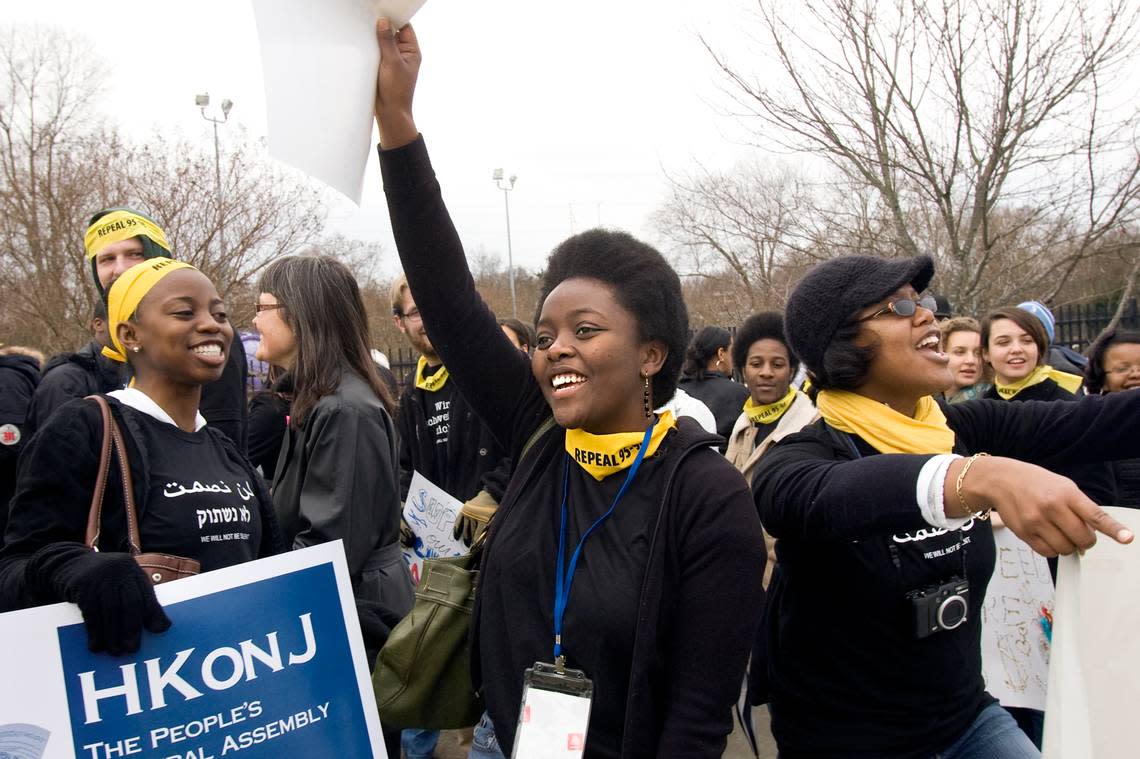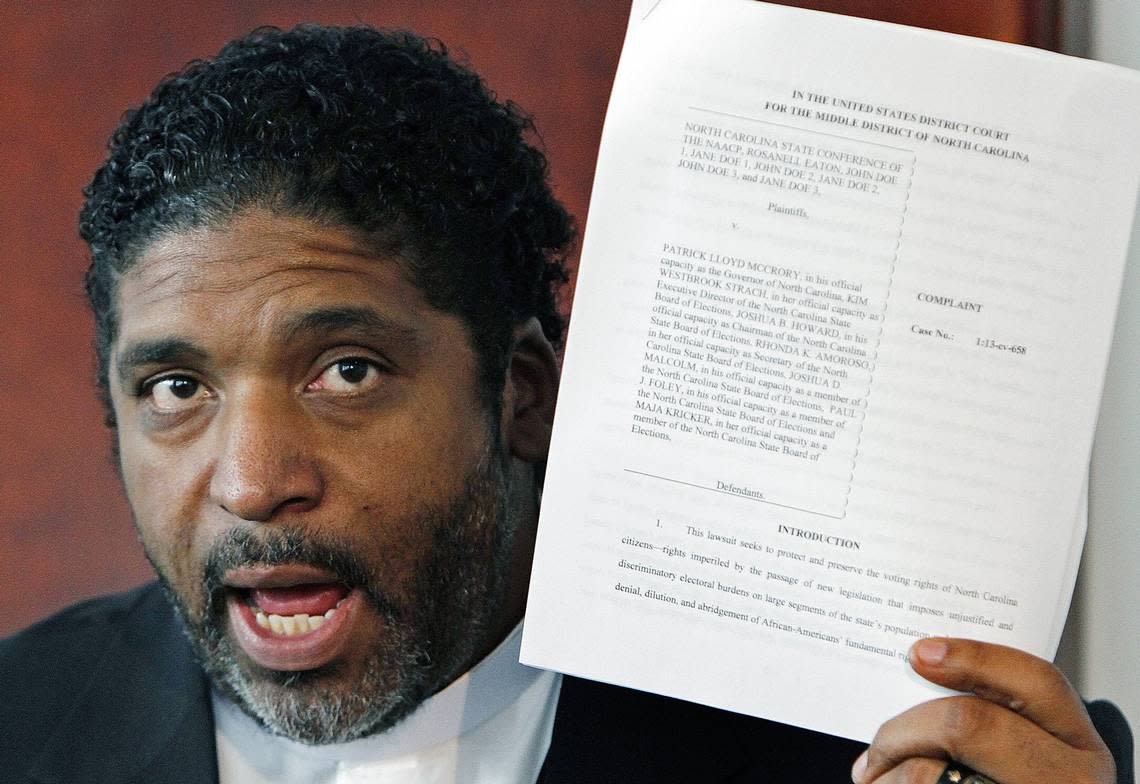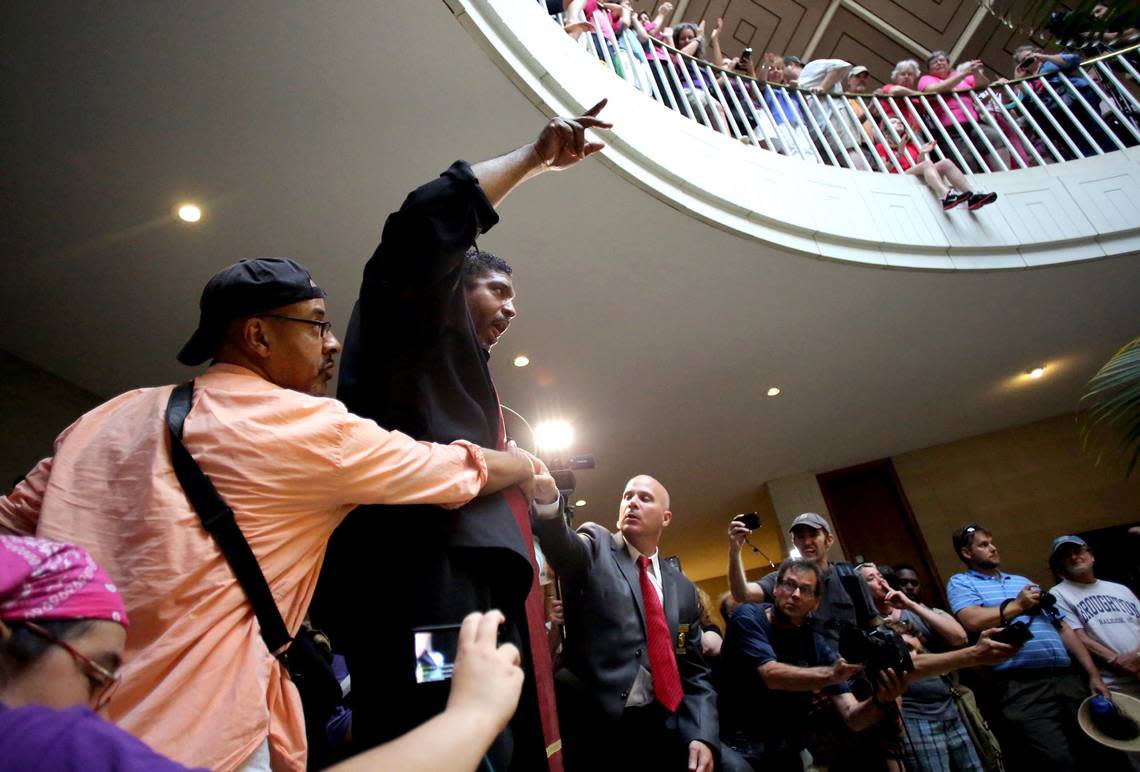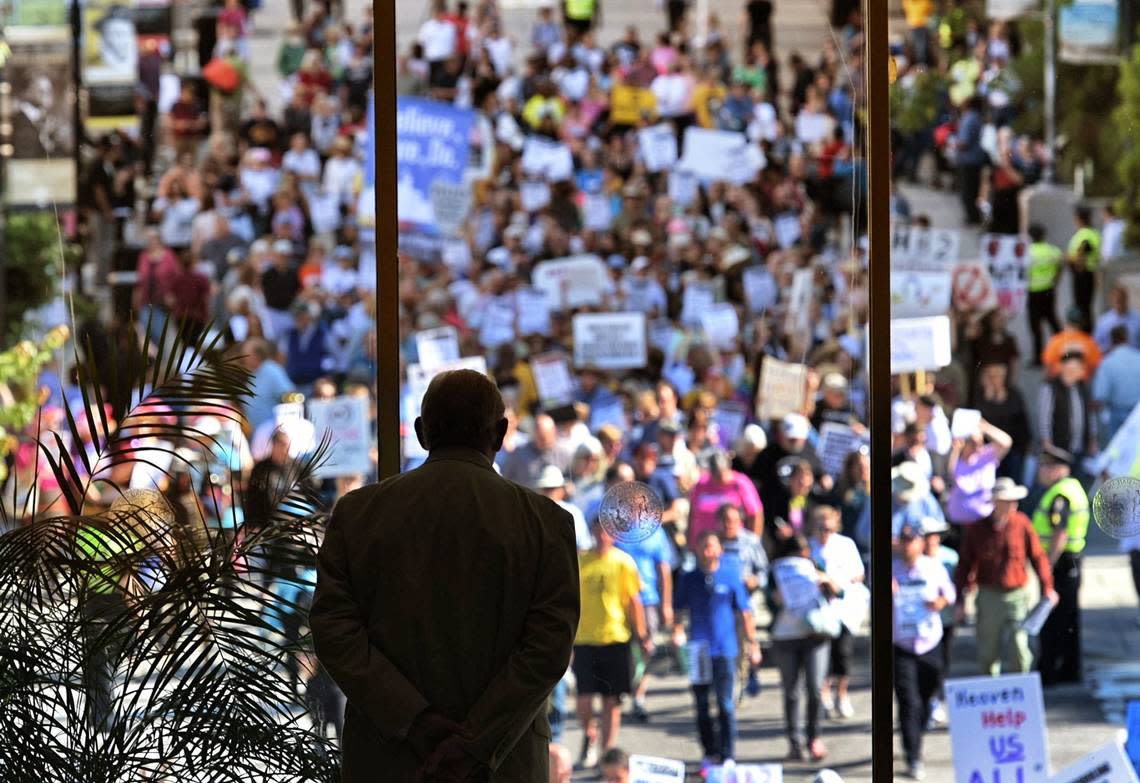Blazing a trail: A timeline of North Carolina NAACP’s history, activism
The North Carolina state conference of the National Association for the Advancement of Colored People, known as the NAACP, was formed nearly 80 years ago in 1943.
Friction has plagued the state conference in recent years, with the loss of its tax-exempt status and allegations of misspending hitting this year. But the state chapter of the nation’s most influential voice for Black people in politics and racial justice movements has been considered a prominent force in issues of racism in public schools, politics, legislation and voting rights.
Much like the nationwide organization, the state NAACP has used marches, demonstrations, lobbying and litigation to put pressure on the public and on elected officials to confront issues that affect African Americans and people of color at large.
North Carolina’s chapter of the NAACP has pushed for change since inception, from supporting the desegregation of North Carolina’s schools in the 1950s to leading nationally renowned Moral Monday marches in downtown Raleigh that pushed back on legislation on a wide range of issues.
It also provided a platform for prominent civil rights activist the Rev. William Barber II, who was president of the NC NAACP from 2005 to 2017. He now leads national protests with the Poor People’s Campaign and his organization, Repairers of the Breach.
Here is a timeline of significant moments in the NAACP’s history in North Carolina:
October 29, 1933: Around 2,500 Black people, many of them public school teachers, gather at Raleigh’s Memorial Auditorium to organize around racial justice activism. The meeting drew attention to pay disparities between Black teachers and white teachers with the same experience and training, according to the book, “Greater Than Equal: African American Struggles for Schools and Citizenship in North Carolina, 1919-1965,” by historian Sarah Caroline Thuesen.
The gathering followed a two-day meeting called by both local and national organizers of the NAACP and paved the way for the creation of the North Carolina state conference, according to Thuesen.
The event aimed to boost the NAACP’s membership, organize local chapters into a statewide conference and bring attention to the NAACP’s primary focus: racial inequalities in American society.
1943-1946: The North Carolina state conference of the NAACP is founded in 1943 with the help of Kelly Alexander Sr., of Charlotte, according to the Encyclopedia of North Carolina. Alexander joined the NAACP in 1938 with a focus on the organization’s legal methods to give full rights to Black Americans.
In the years after World War II, the NAACP grew in North Carolina as a leader in the fight for integrated education and inspired many Black citizens to take direct action against segregation in the Jim Crow era, Thuesen writes. One such example was a 1946 protest against segregation in Lumberton, a town in Robeson County, organized by a local NAACP Youth Council, in which hundreds of students marched, according to historians.
Black activist and NAACP member Ella Baker, who grew up in Halifax County, grew the national ranks of the NAACP during this time as national director of the civil rights group’s local branches, according to The Charlotte Observer.
1948: Alexander Sr. is elected president of the North Carolina State Conference, a post he held until October 1984, shortly before his death, according to the NC NAACP. During his presidency, the North Carolina state conference of the NAACP became the largest in the nation. It eventually included more than 120 branches with a membership of over 30,000, according to the NC NAACP website.
As president, Alexander began a steady attack on segregation. Under his watch, the state NAACP “filed more school integration lawsuits in the late 1940s and early 1950s than any other state NAACP chapter in the South,” historian Tim Tyson told The Charlotte Observer in 2019.
1955: In the wake of the U.S. Supreme Court’s Brown v. Board of Education of Topeka, Kansas decision, Alexander led the NAACP fight to desegregate North Carolina schools, according to the NAACP.
1957: In 1957, 15-year-old Dorothy Counts and three other Black students were admitted to four previously segregated public schools in Charlotte, igniting rage among white parents who were against integration, The Charlotte Observer reported.
April 16, 1960: Baker, of the NAACP, calls a conference at Shaw University in Raleigh to form the Student Non-Violent Coordinating Committee, or SNCC. The group was at the forefront of the struggle for civil rights in the 1960s, The Charlotte Observer wrote in a history of civil rights activism in North Carolina.
The group hoped to build on the momentum from the historic February 1960 protest by four Black college students in Greensboro, who stayed in their seats at a segregated Woolworth’s lunch counter after staff refused to serve them. It sparked a movement of similar sit-ins across the South by thousands of students at segregated establishments.
1965: Alexander, the North Carolina NAACP president, and his family narrowly escape injury in the late-night bombing of his home by white supremacists who are against his work with the NAACP, according to his 1985 obituary in The New York Times
1971: The NAACP Legal Defense Fund brought the case of Swann v. Charlotte-Mecklenburg Board of Education to the courts. Its landmark Supreme Court decision unanimously upheld busing programs intended to bring about the racial integration in U.S. public schools.

2005: Barber becomes president of the state chapter of the NAACP, with his goal “to give new energy and a new battle cry to an organization that he worried had become too lethargic,” according to previous N&O reporting.
2007: The movement that started the Historic Thousands on Jones Street marches in Downtown Raleigh, more commonly known as HKonJ, begins under the leadership of Barber and the state NAACP among Goldsboro clergy.
The annual marches would go on to partner with around 200 other groups and bring thousands to Raleigh’s streets to make broad demands of the government for racial and gender equity in legislation, public education, colleges and more.
September 24, 2010: The NAACP files a federal complaint against Wake County schools with the support of the state chapter, alleging that its majority-white school board violated the Civil Rights Act by proposing policies that would make Wake schools more racially homogeneous.
By organizing protests and litigating, the state NAACP brought nationwide attention to the issue in the state’s largest school district, which had been praised for its integration policies that improved the performance of Black and Latino students, according to The New York Times.

November 4, 2011: Joined by four other organizations, the state NAACP sues the state of North Carolina over electoral districts that a state court would later find as being racially gerrymandered. The lawsuit raised state and federal claims that the districts drawn by Republican legislators were unconstitutionally based on race.
April 29, 2013: Moral Monday protests at the state legislature begin under Barber’s direction, casting a national spotlight on North Carolina politics. Barber and 16 others, mostly fellow clergy, are arrested outside the General Assembly chambers and accused of trespassing and failure to disperse, The N&O previously reported.
Participants in the weekly state NAACP-led Moral Monday protests criticized legislation from a majority Republican legislature under former Republican Gov. Pat McCrory.
Through the summer of 2013, more than 1,000 people were arrested for acts of civil disobedience at Moral Monday gatherings, The N&O reported.

October 2017: Barber steps down as NC NAACP president to organize the Poor People’s Campaign in Washington, D.C. and 25 states. By this time, he has led the organization for a decade and at the same time, has gained a high profile in social justice activism on the national stage.
The Rev. Anthony Spearman is elected as president of the state NAACP. Spearman, president of the NC Council of Churches, said he aims to continue a “fusion movement,” similar to the one Barber helped create, according to previous N&O reporting.
The organization continues its focus on a range of issues that include education equality, criminal justice reform, workers’ rights, anti-poverty, health care and immigration reform.

November-December 2018: Barber and Spearman gather outside the state Legislative Building with hundreds of people to protest a Republican state Senate bill requiring a photo ID to vote.
The state NAACP and its local chapters sue North Carolina over the voter ID requirement, Senate Bill 824. The lawsuit alleges that the voter ID provision disproportionately affected African American and Latino residents in violation of the Voting Rights Act and the 14th and 15th Amendments of the U.S. Constitution.
November 2021: Deborah Maxwell, former local NAACP president of Wilmington, makes history by becoming the first woman to be elected president of the state NAACP. Maxwell tells The N&O that she would keep the NAACP’s focus on the ongoing voter ID law and redistricting issues with Republican legislation as a priority. Its membership includes more than 100 adult, youth and college NAACP units across the state.
Sources: The News & Observer and Charlotte Observer archives; NAACP website; www.ncpedia.org/national-association-advancement-co; The Encyclopedia of North Carolina; https://raleighapexnaacp.org/history-of-the-naacp. “Greater Than Equal: African American Struggles for Schools and Citizenship in North Carolina.”
